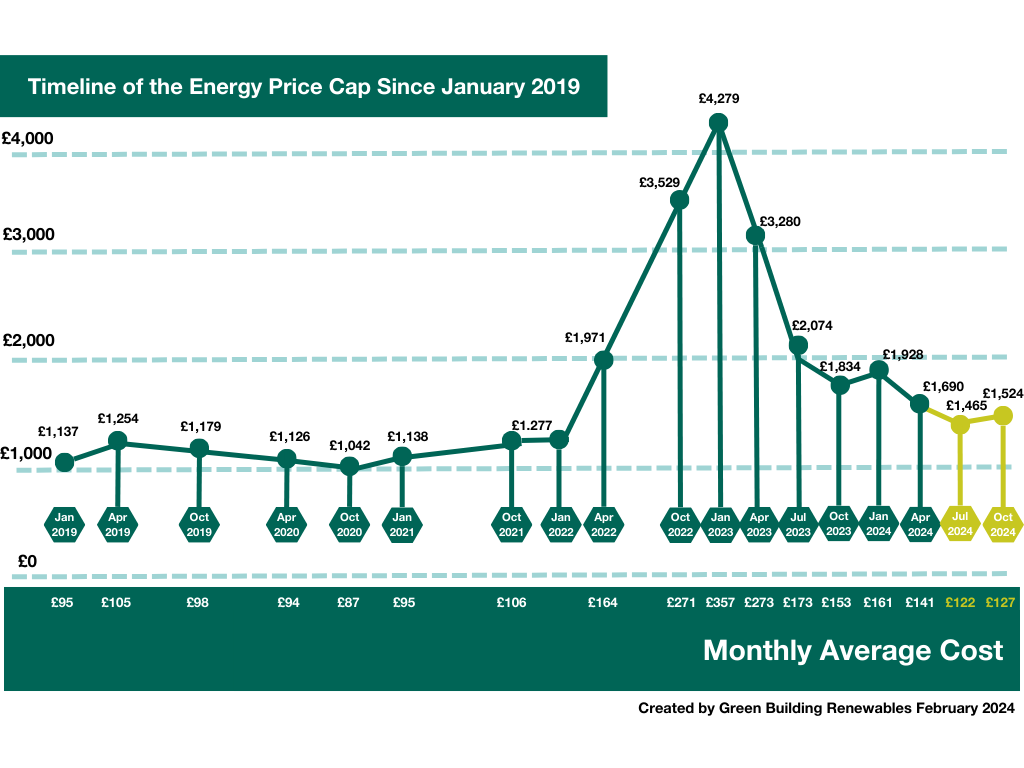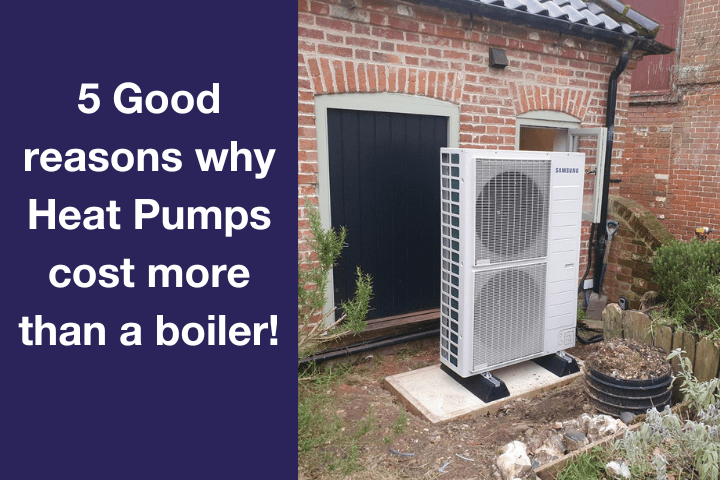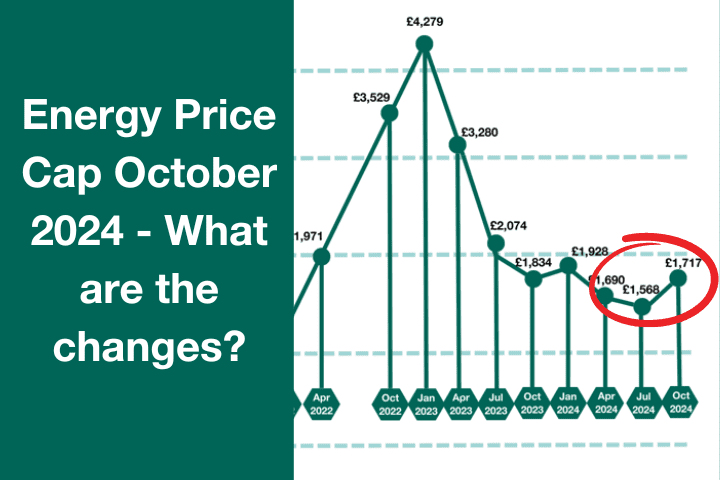Ofgem Energy Price Cap April 2024: 3 Fascinating Graphs to Understand it Better

Table of Contents
What does the new Energy Price Cap mean?
Ofgem has reduced the Energy Price Cap. It is the lowest it has been for nearly two years. A reduction of £238 from the previous price cap level of £1,928 now sees a new rate of £1,690 for the average annual dual fuel bill.
While the average rates per kW for electricity and gas have decreased, the daily standard charges have increased.
The key details to know about the New Energy Price Cap
New Energy Price Cap Rates 1st April – 30th June 2024 (h4)
- Average dual fuel bill: £1,930
- Electricity unit rate: 24.50p/ kWh (+4.6%) plus 60.10p/ day
- Gas unit rate: 6.04p/ kWh plus 31.43/ day
The previous energy price cap rates 1st January 2024 – 31st March 2024
- Average dual fuel bill: £1,928
- Electricity unit rate: 28.62p/ kWh plus 53.37p/ day
- Gas unit rate: 7.42p/ kWh plus 29.62p/ day
Why is the new Energy Price Cap a good thing?
We welcome the reduction of the energy price cap. Cheaper energy bills are good news for everyone, especially during a cost-of-living crisis like the one we are experiencing now.
A reduction in the cost of energy represents a positive development for consumers, businesses, and the energy industry as a whole. This reduction relieves households facing energy bills and fosters a more competitive and efficient energy market.
The reduction offers immediate relief to households, particularly those on fixed or lower incomes, by easing the financial burden associated with energy expenses. Additionally, businesses can benefit from reduced operating costs, enabling them to invest more in growth, innovation, and job creation.
“In the ever-changing landscape of energy costs, consumers often find themselves experiencing fluctuating prices. The drop in energy bills we are hearing today offers a temporary respite, but they remind us of the volatile nature of traditional energy sources. Reflecting over the last five years, it’s evident that energy prices are extremely volatile, so the need for sustainable energy solutions remains as crucial as ever.
“The energy price drop announcement says that we can expect prices to lower by £238. We greatly welcome this news for our customers and Brits alike as it assures a temporary relief to the cost-of-living crisis. However, renewable energy technologies emerge as offerings of stability and resilience in this very temperamental energy cost environment. Renewable technologies such as solar panels and heat pumps provide a reliable alternative to traditional fossil fuelled energy bills, and despite the current relief in energy bills, these solutions offer long-term cost savings and environmental benefits that extend far beyond short-lived fluctuations.”
Chris Delaney, Managing Director of Green Building Renewables
A lower Energy Price Cap should encourage market competition and innovation within the energy sector. It incentivises energy providers to deliver more cost-effective solutions, driving efficiency improvements which will benefit consumers through lower prices and improved service quality.
At Green Building Renewables, we recognise the importance of balancing affordability and sustainability in the energy sector. While reducing the Energy Price Cap offers short-term relief, it’s essential to continue investing in renewable energy sources and energy efficiency initiatives to ensure a sustainable and resilient energy future for all.
The reduction in the average annual dual fuel bill and the average monthly payments for households is excellent news for consumers, and the lowest rates in two years are a step in the right direction. But, and yes, there is a but, it is worth remembering that this new figure is still £500 more per year than it was two years ago in January 2019.
The UK is leading the way in renewables
While we are still dependent on fossil fuels in the UK, particularly as burning natural gas generates 42% of the UK’s electricity, we will remain Energy Price Captives. We wrote about the phenomenon in May 2023 about how, ever since the Energy Price Crisis, as a nation, we have become obsessed every three months with Ofgem’s update on the Energy Price Cap. But, and yes, that’s another one, it doesn’t have to be that way, as renewables offer a natural solution for the nation and individual households.
This month, the UK government announced that it was the first major economy to halve its emissions – having cut them by 50% between 1990 and 2022 while also growing its economy by 79%. This compares to a 23% reduction in France and no change in the USA between 1990 and 2021.
A significant contributing factor to this achievement, which we can all be proud of, is that renewables now account for more than 40% of the country’s electricity – up from just 7% in 2010.
Why should consumers also embrace renewables now?
At the national level, we are leading the way by embracing renewables for our energy generation. But as consumers, we can also take the lead for our homes by embracing renewables and low-carbon technologies to reduce our energy bills further, be less reliant on the grid, and, most importantly, reduce our household carbon footprints.
Households can eliminate the need for fossil fuel heating with a heat pump and live off the gas grid completely. With grants of £7,500 available to install this highly efficient technology, it has never been a better time to get one.
At the same time, households can heavily subsidise their annual electricity consumption by installing solar to generate their electricity. Families can save even more and reduce their energy bills when coupled with an innovative battery storage system. And if you get a renewable tariff, too, then in theory, you can make your home entirely fossil-fuel-free for heating and power.
Today’s announcement about the Energy Price Cap is great news. We see this as a catalyst to inspire and empower households further to see the benefits of lower energy bills and how renewables can make them even lower. We know that choosing renewable technology for your home is a big decision. Still, we have pulled together three graphs that help create a clearer picture of why choosing renewables matters and, if you can, why it is smarter to choose them sooner rather than later.
Graph 1 – The Energy Price Cap Timeline

Today’s Energy Price Cap reduction is excellent news. However, short-term fluctuations don’t accurately depict the situation. The graph above shows where today’s announcement fits in the bigger picture.
The graph (in green) shows how the Energy Price Cap has fluctuated in terms of the average and monthly costs for dual fuel households over time. It also shows (in yellow), according to early predictions, what the Energy Price Cap is expected to do in the following two announcements for this year.
The average dual fuel bill is still over £500 more than what it was in the pre-pandemic and pre-energy crisis world. It is doubtful that energy bills will return to pre-pandemic values anytime soon. As tragic global events have demonstrated in the last few years, the energy price cap is highly volatile, and things outside the average household’s control can significantly impact it. Based on global affairs, it is more likely to go up than down.
Graph 2 – The Price of Gas
When considering the Energy Price Cap Timeline, it’s always worth looking at it in line with the cost of Gas in the UK. Statista Graph showing the Average Price of Gas in the UK 2015-2023

It’s no coincidence that the Energy Price Cap peak correlates with the UK gas price peak. It is perhaps the best determinant of the Energy Price Cap. In the UK, we depend too much on natural gas, and when global events affect its price negatively by increasing its value, this tends to be reflected in the Energy Price Cap, too.
What Factors affect the price of Natural Gas in the UK?
Several factors affect the price of natural gas in the UK, which can impact energy prices.
Global Market Dynamics: Global supply and demand dynamics influence natural gas prices in the UK. Factors such as geopolitical tensions, production levels in major gas-producing countries (e.g., the United States, Russia, Qatar), and international trade agreements can impact global gas prices, affecting prices in the UK.
This has been very apparent in the last few years when considering global events like the Ukraine conflict, which began escalating at the end of 2021, leading to the Russian invasion in February 2022.
Weather Conditions: Weather patterns play a significant role in determining the demand for natural gas. Cold weather, like we saw this winter, increases the need for gas for heating, leading to higher prices during winter. Conversely, milder weather can reduce demand and exert downward pressure on prices.
Supply Infrastructure: The availability and condition of natural gas supply infrastructure, including pipelines and storage facilities, affect the cost of transporting and storing gas. Any disruptions or limitations in the infrastructure can impact supply reliability and potentially lead to price fluctuations.
Liquified Natural Gas (LNG) Imports: The UK imports a significant portion of its natural gas in the form of LNG. Changes in global LNG markets, including liquefaction capacity, shipping costs, and LNG prices in other regions, can influence the availability and cost of LNG imports to the UK, thereby impacting domestic gas prices.
Storage Levels: Gas storage levels within the UK and Europe can influence prices. Adequate storage levels provide flexibility in meeting demand fluctuations, helping to stabilise prices. Low storage levels or concerns about storage capacity constraints can lead to price spikes during periods of high demand.
Currency Exchange Rates: Natural gas prices are often denominated in US dollars. Exchange rate fluctuations between these currencies and the British pound can impact imported gas costs and domestic prices.
Regulatory Factors: Regulatory policies and government interventions, such as energy taxes, carbon pricing mechanisms, and market regulations, can all affect the overall cost structure of natural gas production, distribution, and consumption, thereby influencing prices in the UK market.
Renewable Energy Policies: Policies promoting the transition to renewable energy sources can influence natural gas prices by altering the demand for gas-fired power generation. Increased deployment of renewables can reduce the need for natural gas and exert downward pressure on prices.
So, more renewables in the UK and more electricity generated in the UK by renewables means that the demand for gas decreases and the prices will come down. With the recent news that about 40% of the UK’s energy comes from renewables, there is hope that this will further drive the gas price down.
Graph 3 – The one that matters
When considering embracing renewables and powering your home with clean energy like solar power, perhaps only one graph really matters.

Caption – Climate.gov graph of global surface temperature since records began
2023 was the hottest year on record. The hottest years on record have all been in the last ten years. Climate change is undeniable, and it is causing the planet to warm.
This is having tangible effects on the globe and in the UK. Many of these impacts harm the planet, as we have seen with more extreme weather events worldwide and in the UK, like more winter storms and flooding. Counter-intuitively, though, some impacts of the rising temperatures might benefit renewables like the UK’s solar technology.
According to Statista.com, the UK has seen a noticeable increase in sunlight hours in May, June, and July since 2018. The average annual number of daily sun hours in the UK has remained above four hours per day since 2001. In 2022, the figure increased to 4.9 hours per day.
The graph above, the one that matters, is a stark reminder that if we don’t take action to move away from fossil fuels and face the challenges of rising temperatures head-on, then we face a genuine crisis.
At Green Building Renewables, our vision is to help people make their lives more sustainable and lower their environmental and carbon footprints. The renewable technologies we install do that. They empower people to make better decisions for their homes, future generations, and the environment.
In qualitative research we have conducted with our customers, we are forever inspired by why they install renewable technology. It is easy to assume that most people install renewable technology to save money on energy bills. But this simply isn’t the case. The payback time on installing solar technology is still several years. When asked, most of our customers are choosing to install solar panels and heat pumps not to lower their bills but to reduce their environmental impact.
Many of our customers choose renewables to positively impact the world they leave behind for their children or grandchildren. Our customers are choosing renewables not because saving money is good but because reducing their carbon footprint is the good thing they want to do.
There are many reasons why people continue to choose renewable energy, even if the prices of traditional energy sources are temporarily decreasing. Our customers are tired of being Energy Price Captives. They see freedom, security, and a sense of doing good as reasons for choosing renewables.
The Top Five reasons our customers choose renewables
Freedom
Our customers say installing a solar and battery system can generate their electricity from the sun. This reduces their dependence on the grid and the energy market, shielding them from potential energy price rises and fluctuations in the Energy Price Cap.
As energy prices fluctuate in the future, they feel they can rely on self-generated power, which remains unaffected by market conditions. Many of our customers’ feedback on how good it is not to have to listen to all the news on energy, knowing that they are generating free energy from the sun.
Security
Our customers say solar and battery installations provide increased energy security during power outages or disruptions. A battery system can store excess energy generated during the day and use it when the grid is down, ensuring a continuous power supply. Customers describe features like Storm Watch on the Tesla Powerwall as game-changers. This reduces their vulnerability to energy supply disruptions and potential price surges during such events.
Control
Renewables give you control.
Solar power also allows customers to lock in some energy costs at a fixed rate. Once the system is installed, the cost of generating electricity from the sun remains relatively stable, regardless of external factors such as fossil fuel prices or grid fluctuations. This stability protects our customers from unpredictable energy price rises, providing long-term financial security. Customers can earn money for any excess electricity they generate and feed back into the grid.
Grid electricity prices are subject to various factors, including fuel costs, infrastructure investments, and regulatory changes. These factors can contribute to rising energy prices over time. By incorporating a battery storage system into your solar installation, you can store excess energy during times of low demand and use it when prices are higher. This allows you to rely less on grid electricity, shielding you from potential price increases.
Traditional energy providers often charge higher rates during peak demand periods, such as evenings when households consume more electricity. With a solar and battery system, our customers describe how storing energy during these peak times reduces or eliminates the need to draw power from the grid when rates are highest. This strategy helps them avoid peak-time pricing and prevents associated cost escalations.
Wisdom
With excellent knowledge comes great power.
Many customers report how much they love knowing more about their energy consumption. Using the apps with solar panels and solar battery storage allows them to see real-time usage, how much electricity the panels produce, and what they have stored.
This greater knowledge about their energy usage is empowering. This is in contrast to intelligent monitors in our homes for electricity, which can feel like a snitch in the corner of the room, just reminding you how much energy you use and counting the pounds and pennies you are losing. With solar and battery apps, it is the opposite feeling. Customers get to see how much money they save by being environmentally responsible.
Feeling good for doing good
Our customers keep telling us they feel good about doing the right thing. Cynics may describe this as smugness. Simply put, there is something emotionally rewarding about investing in your home, family, and the environment for the future.
Renewables add value to your home in more ways than just financial value. It is an investment in more than just financial capital. It is also an investment in environmental and social capital. The three spheres of sustainability that our customers choose to embrace when they pick renewables
And finally…
The Energy Price Cap will be news again in a few months, and then again, and then again. Traditional energy prices will continue fluctuating for reasons that are out of our control. However, renewable and low-carbon technologies allow us to meet basic human needs like security, control, freedom, wisdom, and happiness.
If you want to talk to us about how renewables can transform your home and empower you, then get in touch today.




